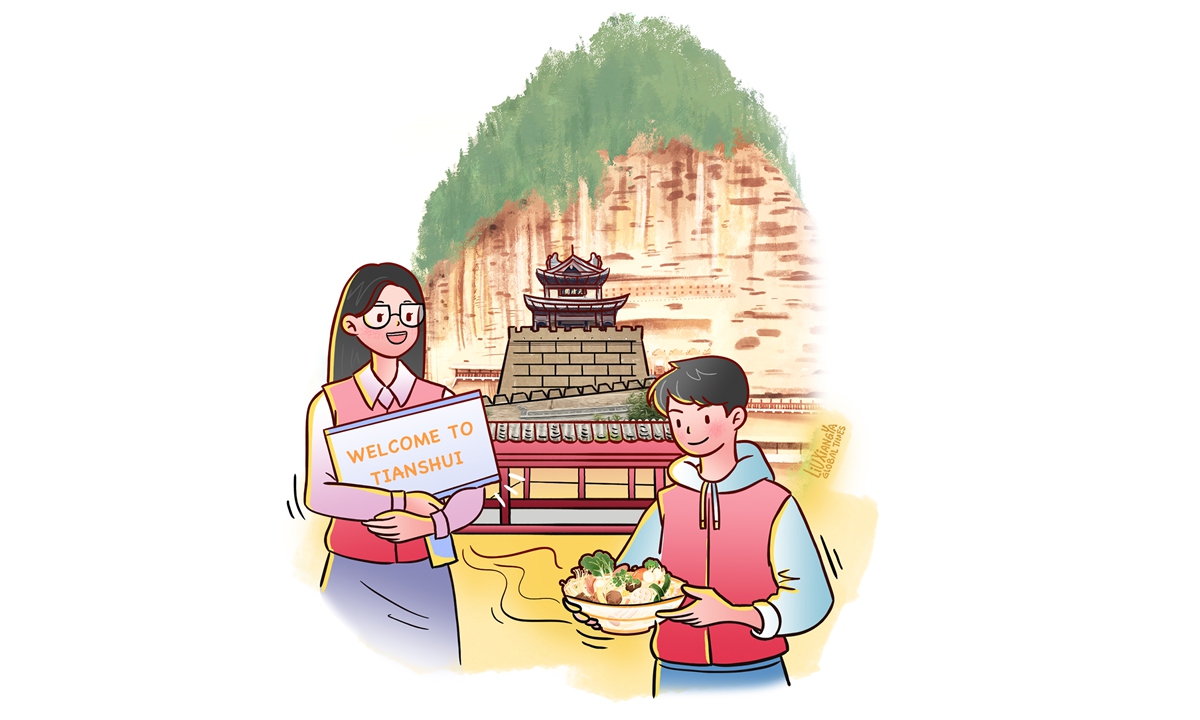
Illustration: Liu Xiangya/GT
After
malatang, a type of spicy food, went viral on the internet in mid-March, Tianshui, a city in Northwest China's Gansu Province, has witnessed and embraced the arrival of a cultural tourism "spring."
The city has hosted more than 2.36 million tourists since the beginning of March. Local tour guide Gao Kejian told me that according to his recent work experience, "10 out of 10" travelers have asked to go eat
malatang immediately upon their arrival.
Tianshui
malatang requires a chef swiftly dab vegetables and meat in boiling soup multiple times. The soup base contains Chinese peppers and dried chili peppers. These two ingredients provide the tongue numbing sensation and a spicy taste that Chinese call "mala."
As a Sichuan local, I know all about
malatang since it is the signature dish of my home province. However, as I walked down Siheyuan street, Tianshui's most popular
malatang street, I finally got to see the local version made using the unique "Gangu chili pepper."
The "Gangu chili pepper" is named after the city's neighboring Gangu county where it is vastly planted. Unlike the pungent peppers used throughout Sichuan, the Tianshui pepper is aromatic and juicy. Ding, a local chef, told me that it "burns in the mouth but is smooth in the stomach."
Maybe due to this incomparable sensation, the local dish has intrigued spiciness challengers from many other provinces like nearby Shaanxi and even farther regions. For instance, one traveler I talked to, A Qiang, told me he had come from the Hong Kong SAR, about 2100 kilometers away.
What surprises me the most isn't entirely its popularity, but that a "
malatang microcosm" seems to have formed in Tianshui in less than two weeks.
Take Siheyuan street. The local government has reorganized traffic flow, added security personnel, a "
malatang booth" and student volunteers to guarantee safety and information services. Business runners like chef Ding has acquired a new profession as a "
malatang internet celebrity." He has committed himself to cooperating with vloggers and media from all around the country to livestream videos of him cooking local food for netizens to enjoy.
All these changes made me wonder how Tianshui has capitalized on this gourmet trend to boost its local tourism.
The question was seemingly answered as I wandered around the city's tourist sites like Tianshui Ancient City.
Tianshui Ancient City is an ancient architecture compound established during the Ming (1368-1644) and Qing (1644-1911) dynasties. One month ago, it was popular as a great place for an "after-dinner" walk, but now it is dotted with booths promoting agricultural specialties, historical sites and cultural creative products not only in Tianshui city, but also in the rest of Gansu Province.
Jia Zheng, a cultural tourism expert, told me that the strategy focuses on using a single food point to promote the entire tourism industry and aims to engage people in the city's cultural history.
Located in Tianshui's Maiji district, the Maiji Mountain Grottoes is the city's most prestigious cultural heritage. It boasts Asia's largest number of clay sculptures dating back to the Northern Dynasties (386-589).
On Tuesday, the No.39 bus route was newly opened to take visitors to the grottoes right after enjoying
malatang tasting at the city center. The bus route includes other local heritage sites like Jingtu Temple and Xianren Cliff.
The grottoes welcome around 5,000 people per day. To balance tourism and conservation, Li Tianming, director of Art Research Institute of Maiji Mountain Grottoes, and his team have improved the booking system and added new activities such as Tianshui folk dances and "heritage quizzes" to make wait times more entertaining.
Responding to the drastic rise in visitors, the city's Tianshui Museum has just revealed a gold gilded stone sarcophagus to visitors. The museum's most precious item, it had never been exhibited before.
"I've never seen tourism gala like this in my eight years of working here. We want people to experience the city's culture," said a museum worker surnamed Yang.
Tianshui's "food to culture" maneuver has no doubt been a success. Liang Daifeng, a local cultural policy expert, told me it reveals how the experience economy has the power to become a "new quality productive force" for the small city's cultural and social growth.
"We see the power of 'food and tourism' this time, and in future, we anticipate seeing other combinations like 'agriculture and environmental tourism," Liang noted.
Although it was small, I was surprisingly also able to find an example of environmental tourism in Tianshui.
Located in the city's suburban Panji Town, the Yangzheng Library is China's first carbon neutral reading facility.
The "green" building is equipped with 80 photovoltaic modules that generate electricity. Including these devices and other installations like wind turbines, the building's energy efficiency rate has surpassed 166 percent, overtopping its energy consumption to have fulfilled the zero waste mission.
Initially designed for local villagers, it has now become a hot tourist spot for young travelers.
Before I came here, my only goal was to understand the charm of
malatang, but now I see a fuller image of the city and I understand why my local guide Huang Haifeng described
malatang as an "engine" for Tianshui tourism.